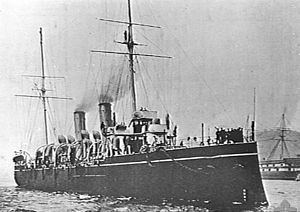Name HMS Pegasus Motto "Excelsior" Length 91 m | Ordered 1893 Commissioned 17 January 1899 Launched 4 March 1897 Draft 5.2 m | |
 | ||
HMS Pegasus was one of 11 Pelorus-class protected cruisers ordered for the Royal Navy in 1893 under the Spencer Program and based on the earlier Pearl class. The class were fitted with a variety of different boilers, most of which were not entirely satisfactory, and by 1914, four ships had been withdrawn. They had all been condemned in 1904 but were reprieved and remained in service, with scrapping proposed in 1915.
Contents
History
Pegasus was completed in 1898, and in 1899, she was stationed off the southeast coast of America. She was commissioned at Chatham on 21 May 1901 by Commander Edmund Hyde Smith, to serve at the Mediterranean Station. In June 1902 she was in Gibraltar for a coronation fête. She was later stationed at Australia, China, and finally Africa, serving on the Cape of Good Hope Station in 1906.
In 1908, Pegasus rescued the crew of the wrecked French barque President Félix Faure, who had been stranded for sixty days on the Antipodes Islands.
Sinking
In the early morning of 20 September 1914, Pegasus was anchored in Zanzibar harbour, having left her battlegroup, which included Hyacinth and Astraea, to attend to boiler and engine problems. The German light cruiser SMS Königsberg launched a surprise attack on the ship. Outranged and outgunned, Pegasus was incapacitated within eight minutes, and the captain — Commander Ingles — struck the colours to avoid further bloodshed. The ship sank later that day, with 38 lives lost and 55 wounded. The hospital ship Gascon and Scottish ship Clan Macrae came to the aid of the survivors.
Pioneer—Pegasus' sister ship—later assisted in the blockade of the Rufiji River where Königsberg had taken refuge.
Six of the eight guns were salvaged and two, named "Peggy III" and "Peggy IV", were used in the land campaign until 1916. Of the other four, two remained in Zanzibar, one was mounted on board the lake steamer Winifred, and the last mounted at Mombasa where it survives to this day outside Fort Jesus museum. Twenty-four of the British sailors who died in the battle were laid to rest in a mass grave in part of the naval cemetery on Grave Island, Zanzibar; the remaining 14 were buried in the town cemetery, but in 1971 were moved to the Dar es Salaam war cemetery. The wreck was sold in 1955 for £500 and broken up for scrap, although large amounts of debris still remain on the seabed.
